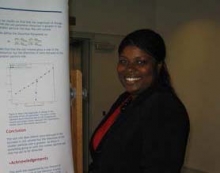
University:
Jackson State University
Major:
Chemistry
Mentor(s):
Brent Melot
Faculty Sponsor(s):
Ram Seshadri
Faculty Sponsor's Department(s):
Materials
Project Title:
BOND LENGTH AND BOND DISTORTION OF FERROELECTRIC BATIO3
Project Description:
BaTiO3 is a ferroelectric oxide that exhibits a phase change from tetragonal to cubic at 130°C.
In the tetragonal structure of BaTiO3 the apical Ti-O bonds are longer than the equatorial
bonds. In the cubic structure the titanium is centered octahedrally surrounded by six oxygen
atoms, with all bond lengths being equal. Recent experiments have shown that as particle size
get smaller bond distortion increases, i.e. one Ti-O apical bond increases while the other Ti-O
apical bond decreases. Experiments also suggest that this distortion is because the size of the
unit cell volume increases with smaller particle size, and the Ti atoms have more freedom to
move off center. With the research presented, we determined if the cell volume is the primary
contributing factor to bond distortion exhibited in smaller particle size. Density Functional
Theory calculations were used to look at these factors using Quantum Espresso. A relaxation
was done to test different cell volumes to get the short and long bond lengths for each value.
The results show that the cell volume does cause the unit cell bond lengths to distort but the
smaller particle size causes a greater distortion.
